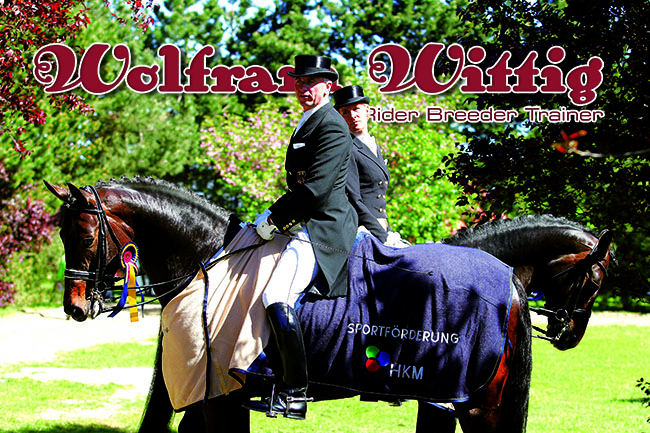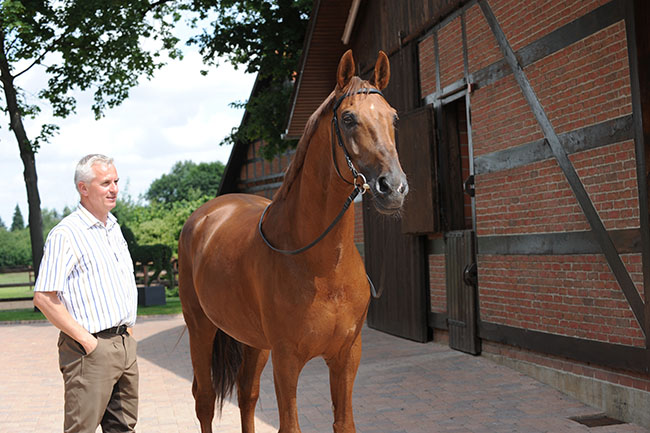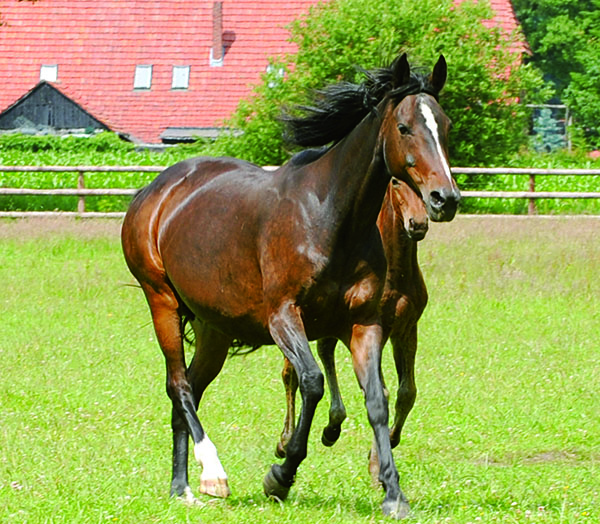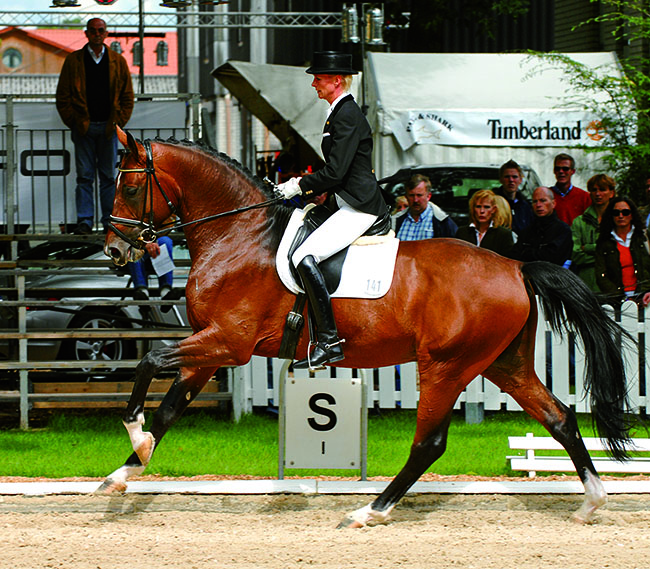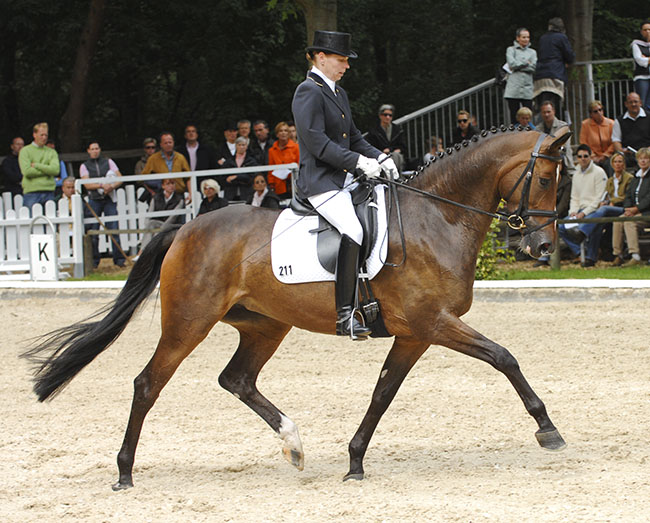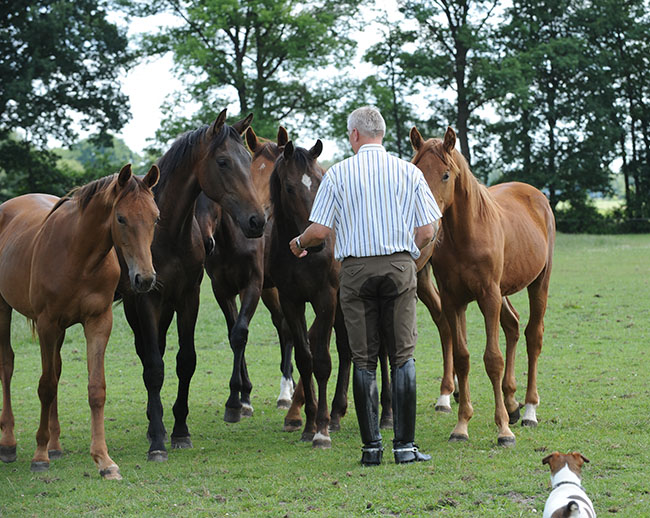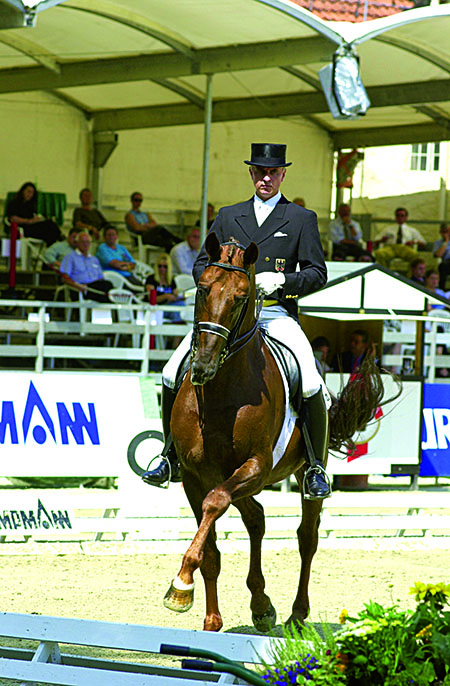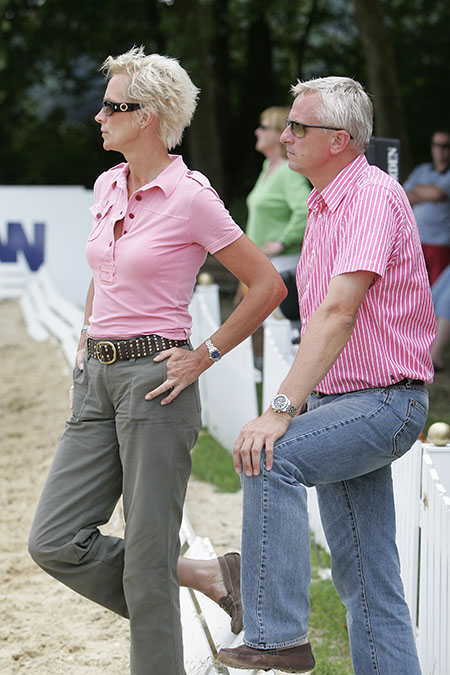Story – Chris Hector Photos – Roz Neave and KH Frieler
I guess it’s hard for Australians to understand just how specialised the German Horse scene is. While in Australia lots of our top riders have bred their own horses, in Germany the breeders tend to be one group, the riders and trainers another, with not a lot of communication between the two. Wolfram Wittig is a spectacularly successful exception to this rule…
Wolfram Wittig has produced no less than eight home bred Grand Prix dressage horses, and ten more at Advanced level. With the assistance of his wife, Brigitte, he has produced thirty five horses of his own breeding at national and regional championships.
The story began in 1990, when Wittig bred his mare Maya, to the Hanoverian stallion, Bismark. Bismark was one of the first products of Bolero, and the only son out of a mare by Duellant. The result was Breitling W.
Wolfram and Breitling – and yes, the stallion stands even when mares and geldings walk past.
The same cross also produced Breitling’s sister, Biagiotti W, an advanced dressage horse with Makus Gribbe. Bred to Woodstock, Maja produced the mare, Watussi W, another international dressage horse. Maya’s full-sister, bred to Bismark, produced the Grand Prix competitor, Barnsby W, and the licensed stallion, Burlington W.
Wolfram is a very funny guy, always quick with a joke, and you get the feeling that perhaps he got serious about breeding because his friends told him it was impossible…
“I started because I had always been interested in young horses, and especially the gaits and the movement. Then everyone was saying to me, if you try to breed, you will not have success, because it is not possible to breed your own sporthorses. And I asked myself, why not? Why shouldn’t it be possible – and now we are doing it.”
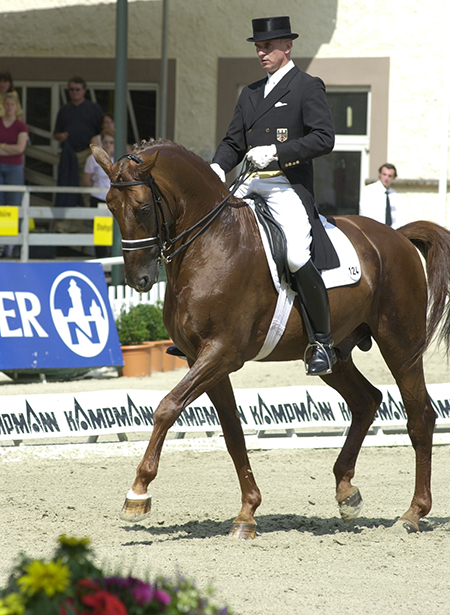
Breitling, a successful sire and performer… And with success…
“Not too bad! We had some mares to start with, but they were not of the quality I’m looking for. Now we are so happy and very proud that our best products are from our own bred mares. Not only from our stallion, but from mares we bred.”
“What was very important to me was Bismark. Bismark was Bolero / Duellant, and the most important bloodline for me in dressage was Duellant. But it is very difficult to find stallions with Duellant. Bismark was a very old fashioned stallion, but the movement was unbelievable and he was totally balanced in all three gaits, so I used him for my breeding program.”
One of the most spectacularly successful of the Wittig’s mares has been Devisa – by the Thoroughbred, Diego out of a grand-daughter of the great Westfalien jumping sire, Polydor.
Devisa – the most successful dressage brood mare ever?
Wolfram is rightly proud of the foals Devisa has produced for him:
“Her first foal was born in 1999, by Breitling, and that is Baldessarini, who is owned now by Gina Capellmann, and she is now qualified for the Young Horse Grand Prix. She has also placed in international Grand Prix. She was 5th at the World Breeding Championships for Young Horses. The next one is eight years old, Biashotti W, she finished third in the six year old class at the Bundeschampionate. The next one is seven years old, Brioni, he’s a stallion and qualified for the Nurnberger Burg Pokal. Then there is Bertoli who is a breeding stallion and was reserve champion at the World Young Horse in Verden. Then Balmera, qualified for the Bundeschampionate. Then Belstaff, four year old stallion, followed by a three year old Baron de Lys…
One of Devisa’s stars, Bertoli, with Brigitte Wittig at the Bundeschampionate
Why did you choose a Thoroughbred as the sire for your mare?
“There’s no reason why not…”
You weren’t worried about getting enough movement for dressage?
“There’s no problem because the father is Bismark / Breitling, so there is no problem. You have some Thoroughbreds with movement; if you breed with Thoroughbreds sometimes it is a very high risk, but all the Stud Books they ask you to use Thoroughbred, but no-body asks about the product. You have to take the risk yourself, and it is a very difficult selection to breed with Thoroughbreds. I prefer if I can to use Thoroughbred stallions that I know, and I know how they move, this for me is very important. If they have good movement for a Thoroughbred – not like a Warmblood, that’s a big difference – then there is no reason not to use Thoroughbreds.”
What stallions will you use with your Breitling mares?
“We have now Charatan, he is Consul / Bismark – Consul is Trakehner and he is out of Bugatti W who is by Bismark. I used the Holsteiner, Carabas, and he sired Cayenne W – also out of Bugatti – who was the World Young Horse Champion in 2007. I use a lot of different stallions but to be honest, not with the same success I had with the Breitlings.”
Cayenne W – the World Young Horse Champion in 2007 – with Susan Pape
and there is another generation waiting in the paddocks…
Tell me about your riding career…
“I started at the age of 13. I trained with a very well known man from the Spanish Riding School, Walter Biedermann, he was in Germany and I worked with him for two years. Then I trained a lot with Mr Rehbein. I had clinics with Harry Boldt, Jo Hinnemann, Jean Bemelmanns, with Klaus Balkenhol as well, because he was the German coach. The main thing is to open your mind to everything…”
It is all based on the classical training scale?
“I don’t know what is classical. If it looks very old, it’s classical… but now the sport is going in a different way, it’s more athletic now. You have to face up to it, it is more athletic. In the past, the women who rode were not good enough, so the trainers worked the horses, and for the last five minutes, the ladies can do the competition. This time is definitely gone and we must be happy that this time is really gone. Now our most successful riders are women. Not only in dressage – also in showjumping, look at Meredith (Michaels-Beerbaum). For me the sport is going in the right direction, it is not for the strong riders, it is more for the riders that are more technical. That is the reason I hate the word ‘classical’. The training should be that we have a really good attitude to our horses, that’s real horsemanship, and that for me is more important. You can hit your horse in a classical way, but that is no nicer for the horse!”
The Australian event rider, Kevin McNab said to me that one of the things he loved about working at your stables, was that everyone was kind to the horses…
“If you breed horses you have a totally different attitude to the ‘sport user’, you have a different mind. All my horses have one scary moment in their life, the first human they detect – that’s me. From that moment it all goes up for them.”
When you train with a rider who has been as successful as Isabell Werth, is this very different from training a ‘normal’ student?
“Isabell is one of the best riders – it is the same when I train my wife. She is a very good rider, and we are together 24 hours. This educates you a lot, when you make a correction, sometimes maybe you are a little bit strong, you like to shout – then my first question to myself is ‘Wolfram would you like to clean up the bedroom? Would you like to cook?’ Then you start to be a gentleman…”
Breitling and Wolfram – Grand Prix competitor – sire of Grand Prix competitors
In case you haven’t got the message, Wolfram Wittig is always cracking jokes.
“With Isabell, it is a two way communication. As a rider you have a feeling but you know we get no marks for our feeling. Dressage is like a peep show, you only get points if it looks good. You get no marks for your feeling. If it looks good and you feel bad, you get high marks, and then you are successful. If your feeling is good and you get bad marks, then you are not successful, that’s it.”
But that is bad judging – because if it looks good and it feels bad, it’s not really good…
“No, it can be sometimes you come out of the competition, and you say ‘oh I had a super feeling’ and you get 65 – not happy!”
With Isabel are you talking about things like rider position, or is it more a psychological approach?
“With Isabell we discuss the whole training with all the horses. All the time we are preparing for shows, and you have to be like her mirror. It’s normal for everybody to make mistakes – then you have to tell the rider, it looks good, it looks bad, that helps the rider because later on, we have five judges, and they only give the marks on how it looks.”
Which do you prefer – Grand Prix competition, or the young horse classes?
“Don’t forget the basics – and the basics have to start with the young horses. If the quality (of training) of the young horses is at a high level, you have an easier life later on. If you work strongly at the basics, then it is definitely easier at the top.”
More about young horse training, read on…
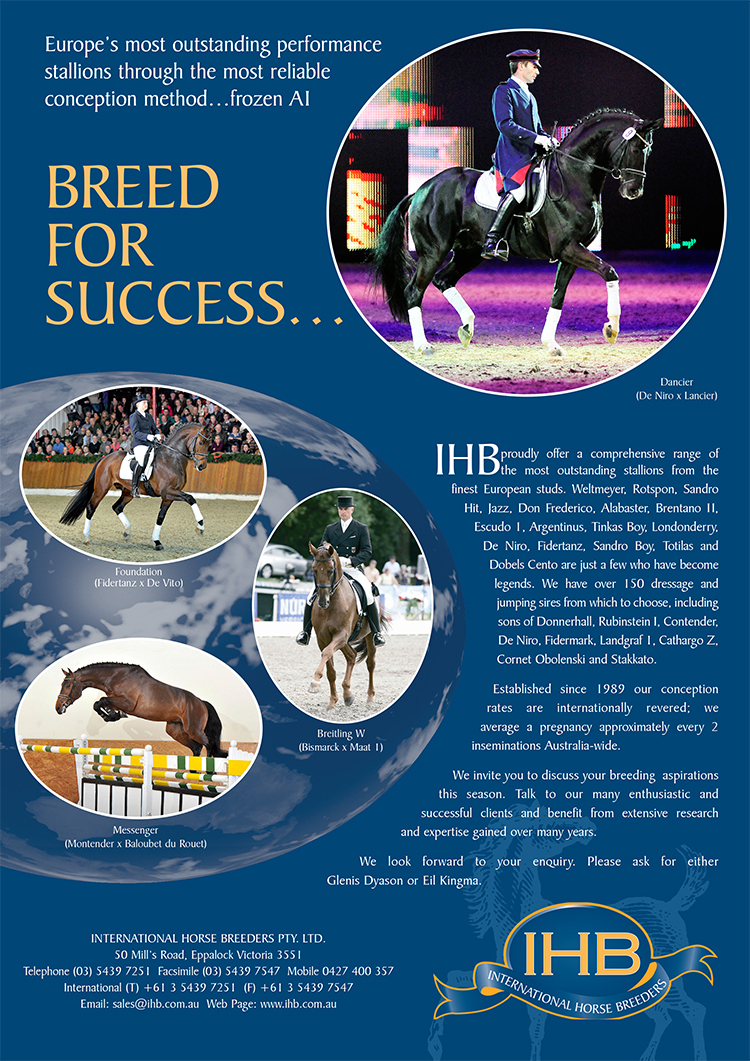
I think it is getting better at the Bundeschampionate – the judges are looking for a more natural way of going…
“Sometimes for me, the Bundeschampionate is too much business. They show us very high marks in the young horse classes, 92 / 93 / 95% and then you only get 68% for the Grand Prix. Look at other sports… long jump, the youngsters jump six metres, later they jump eight metres, in normal athletics the marks get higher as the level of the competition becomes higher – in dressage it is the opposite. They give the young horses 95%, then you have to explain to the client, how is it that we have trained the horse for three years, and now he gets 68% – we must be very very bad trainers. For me it is wrong system – this scoring is only for business.”
But at least now they show the young horses in a less ‘spectacular’ way?
“Sometimes, but if a horse has a really good extended trot, the crowd claps their hands and you can do nothing to stop that, that’s normal, it’s a show. For me, you have to ask one question – if you see the horse in a competition, ask yourself, can you ride the horse every day in this way? You know the answer yourself – in this way it is possible, in this way it is not… And if you get high marks for the other way, then that does not depend on the rider, it is the judges. So then you can do nothing.”
It was time to visit some of the horses, and each and every one of them showed the enormous benefit that good handling produces. Every single stallion, from the three year olds, to the old stagers, like Breitling, stood – rein just tossed over their head, standing up without having to be held with pricked ears – and not one moved, not even when mares went past. Impressive, yes very, just like Wolfram, he’s a guy who has achieved so much yet he keeps his sense of fun and adventure. I guess if you were a horse, it would be a nice stable to find yourself in…
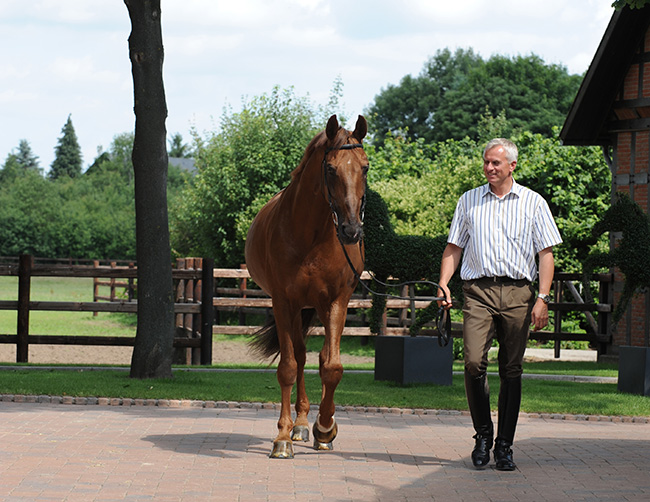
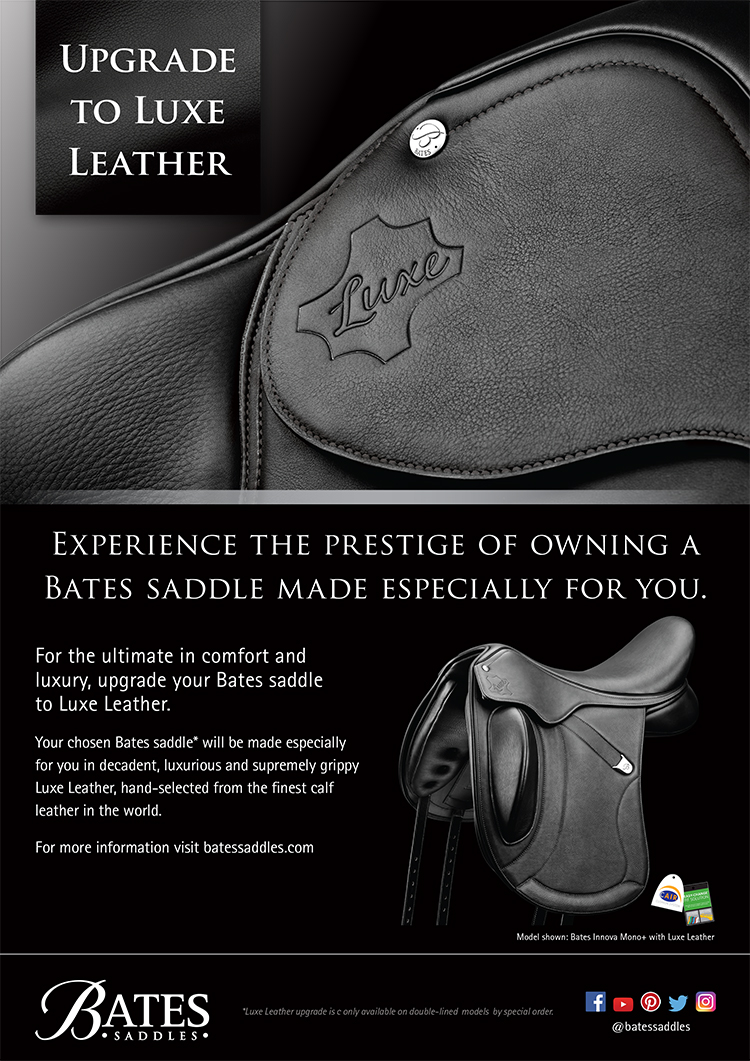
This article originally appeared in the February 2009 edition of The Horse Magazine


